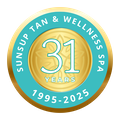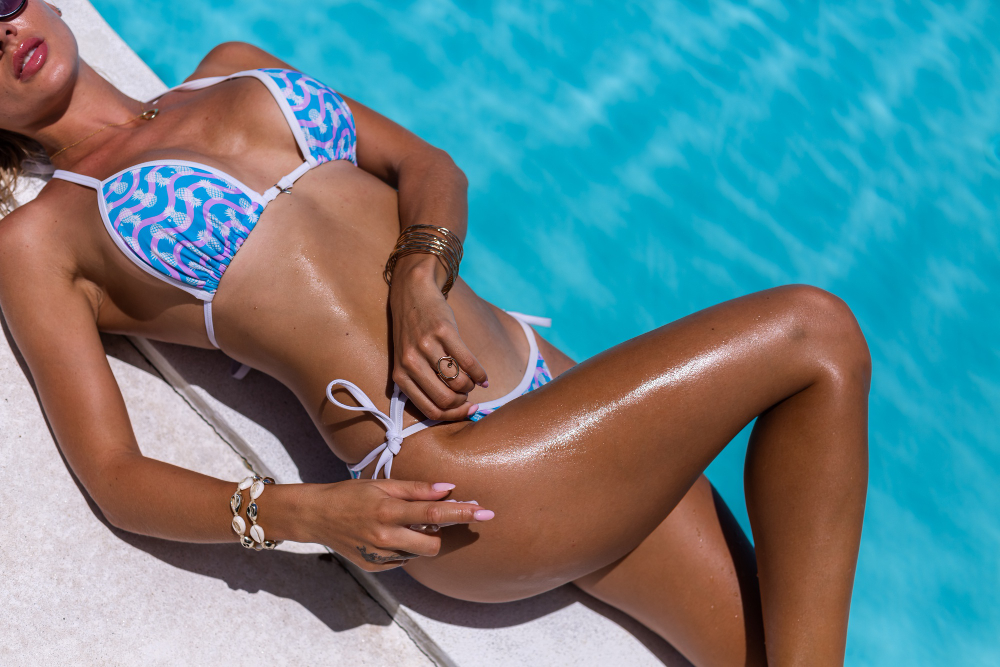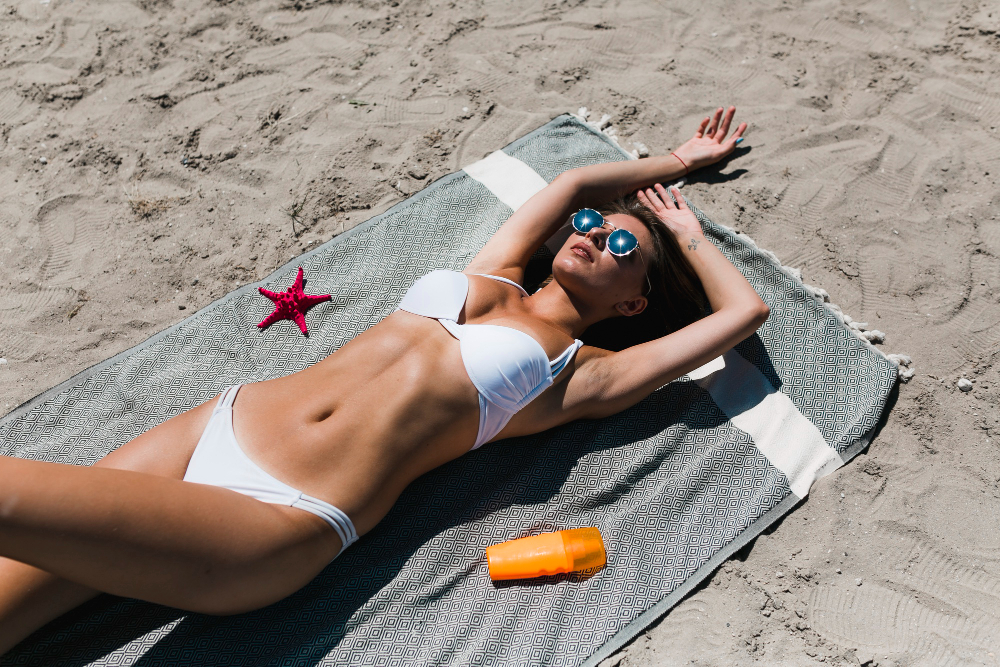We all love that golden glow, but if you don’t know what you’re doing, especially with certain skin types, it can quickly turn into a painful burn. So, how to tan without burning? The key is controlled exposure, smart prep, and tailoring the entire tanning process to your skin type. It’s not complicated. And with this guide, you’ll know exactly how to avoid burning in a tanning bed or outdoors.
How Does Tanning Work?
Tanning happens when your skin is exposed to UV light, which triggers the production of melanin. This is a substance in our bodies that gives color to our skin, eyes, and hair. Understanding what’s really going on when your skin starts to darken can help you make smarter decisions and avoid unnecessary damage.
How Do We Tan?
When your skin is exposed to UV light, melanin steps in to absorb some of that radiation, helping to protect your skin cells from stress. In other words, your tan is literally your body’s shield. The darker your natural skin tone, the more melanin you already have and the more built-in protection you get.
Skin Types and Tanning
Your skin type plays a big role in how easily you tan or burn. One of the best ways to understand your skin’s reaction to sun exposure is by using the Fitzpatrick scale, which helps categorize different skin types based on how they respond to UV light.
- Type I: Very fair, always burns, never tans
- Type II: Fair, usually burns, tans minimally
- Type III: Medium, sometimes burns, tans gradually
- Type IV: Olive or light brown, rarely burns, tans well
- Type V: Brown, almost never burns, tans deeply
- Type VI: Dark brown to black, never burns, already richly pigmented
Why Do I Burn Instead of Tan?
If you burn instead of tan, it’s usually due to overexposure to UV rays or simply your skin type. If you have Type I or II skin, you’ll need to be especially cautious, since you’re more likely to burn than develop a tan.
On the flip side, having a darker skin type doesn’t mean you can spend unlimited time in the sun or a tanning bed. You’re still at risk of burning if you overdo it. And let’s be clear, burning should never be part of the tanning process.
Does Burn Turn into Tan?
No, not really. Burned skin that turns into tan is a myth.
A mild burn might fade into a slightly darker color, but it’s not the same as a real tan, and it comes at a cost. Your skin had to get inflamed and damaged to get there.
Instead, you should look to get real, lasting color that comes from gradual exposure and smart protection.
How to Tan Without Burning – Preparation Steps
To tan without burning, you should pay attention to preparation steps like hydration, exfoliation, and putting on the right lotions. Here is a detailed breakdown of the best practices:
- Hydration and Nutrition: Make sure to drink plenty of water. Hydrated skin tans more evenly and holds color longer. What you eat helps too. Foods rich in beta-carotene, like carrots, sweet potatoes, and spinach, can support your skin’s natural pigment process.
- Exfoliate: Exfoliating removes dead skin cells so your tan goes on smoothly and fades evenly. But don’t do it right before tanning. It’s best to do it 48 hours before tanning.
- Moisturize and Use Right Products: Stick to fragrance-free, oil-free moisturizers. Using a tanning lotion or accelerator? The same rules apply. Make sure it’s designed for your skin type, doesn’t contain oils or alcohol, and is made for indoor or outdoor use. Yes, there are different types of lotions. Don’t mix them up.
If you’re looking for a great tanning lotion, your tanning salon is the best place to find it. For example, at SunsUp Tan & Wellness Spa, we carry top-quality formulas like MR International tanning lotion, an exclusive, salon-only product you won’t find online. So if you want something that really works, come by one of our locations and check out our professional products.
How to Tan and Not Burn in a Tanning Bed
To effectively tan and not burn in a tanning bed, you should consider the type of bed, salon maintenance practices, and personalized assistance. Here’s a detailed breakdown.
How to Choose the Right Tanning Bed and Salon
The first thing to consider is whether you’re going to use low-pressure or high-pressure tanning beds.
Low-Pressure Tanning Beds vs High-Pressure Tanning Beds
Low-pressure beds mimic natural sunlight more closely, with a higher ratio of UVB. That means they can trigger faster burns if you’re not careful, but they also help stimulate melanin.
High-pressure beds use mostly UVA. These are better for deepening existing tans and are generally gentler on the skin, but still pack plenty of power.
Questions to Ask
When choosing a salon, you should check with them:
- How old are the lamps? (Worn-out bulbs can be uneven, unpredictable, or simply stop working if they haven’t been replaced on time.)
- What’s your cleaning and hygiene protocol?
- Do you offer multiple types of tanning beds?
For first-timers, these questions are easier to use when you already know how a session is supposed to run. Our checklist article for first-time tanning at a salon covers what happens when you walk in, how timing is chosen, and what red flags to watch for.
At SunsUp Tan & Wellness Spa, we go above the industry standard. We replace our bulbs at half-life (long before they burn out) to guarantee consistent performance. We use professional-grade cleaning solutions to sanitize beds after every session. And we offer four levels of tanning, so you can choose the bed that fits your skin type, experience, and desired results.
If you wonder how long does a tan last at a tanning bed, here’s the article answering that question.
Personalized Assistance
If you’re new to tanning beds or if you burn easily, make sure the salon has trained staff who can guide you. They should be able to recommend the right bed, session length, and products for your skin type.
That’s exactly what we do at SunsUp Tan & Wellness Spa. Every tanning session is tailored to you, with expert guidance from our Smart Tan Certified staff, a state-required certification they must pass before working independently. Our team can provide you with the best tanning practices, tips on products, and suggestions for the best tanning beds for your goals. So if you’re looking for indoor tanning in the Portland and Vancouver Metro Area, make sure to visit one of our locations.
Session Planning by Skin Type
Overdoing it is the fastest way to get burned. Use the following guide as a starting point, but always adjust based on how your skin responds.
| Skin Type | Start at | Max Exposure | Build-Up Schedule |
| I | Skip UV and choose a spray tan | n/a | n/a |
| II | 4 min | 8 min | +1 min every other visit |
| III | 6 min | 12 min | +2 min weekly |
| IV-VI | 8 min | 15 min | +2 min weekly |
Smart Tanning Bed Etiquette
Here are a few pro tips that can help you tan safely and effectively:
- Always wear proper eye protection (Not sunglasses, not closing your eyes, not a towel over your face, but proper tanning goggles).
- Use lotions made for indoor tanning only (These are designed to boost melanin without damaging the acrylic on the beds.).
- Stick to the 48-hour recovery rule (Your skin needs time between sessions for melanin oxidation to fully develop).
- Cool down and hydrate afterward (Rinse off if you’re sweaty and drink plenty of water).
Outdoor Tanning Without the Burn
The key to outdoor tanning without burning is to select the right time of the day. The sun’s UV rays peak between 11 AM and 4 PM, and that’s when you’re most likely to burn. Your sweet spot? Early morning or late afternoon. So, do it before 11 or after 4.
And yes, you still need sunscreen if you’re trying to tan. Here are a few things to keep in mind:
- Use broad-spectrum SPF 30 or higher.
- Apply it 15 minutes before sun exposure.
- Reapply every 2 hours, or sooner if you’re swimming or sweating.
How to Tan if You Burn Easily?
If you want to tan but you burn easily, you probably fall under the Type I category of the Fitzpatrick scale. In this case, spray tanning, also known as sunless tanning, is the best option for you.
Spray tans use an ingredient called DHA (dihydroxyacetone) that creates a golden-brown pigment on the outermost layer of your skin. It starts developing within 4 to 8 hours and can last for 4-7 days. Best of all, there’s no risk of burns or need for multiple sessions.
Spray tanning is the best for:
- Fair or ultra-sensitive skin.
- Anyone on medications that prevent them from tanning.
- People short on time who need a tan for an event, photoshoot, or vacation.
What to Do If You Get a Tanning Burn?
A little post-tan warmth is normal. Your skin has just absorbed UV. But if that warmth turns into stinging, tightness, or sensitivity to touch, you’ve crossed into burn territory.
If your skin looks overly red and feels hot hours later, that’s a sign of a burn, not a tan.
Here’s what you can do to make it easier:
- Get out of the sun or tanning bed immediately. Don’t try to “push through” and finish a session. More exposure = more damage.
- Apply cool compresses to the affected area. Not ice, just a clean cloth soaked in cold water. It helps draw out heat and soothe the skin.
- Use an after-sun gel or lotion that contains aloe vera, panthenol, or hyaluronic acid. These ingredients calm inflammation, speed healing, and rehydrate the skin barrier. Reapply often.
- Drink water. A burn dehydrates you from the inside out. Start replenishing right away.
And here is what you should definitely avoid:
- No ice directly on the skin. It can cause more damage.
- Don’t exfoliate or pick. Let the skin heal naturally. Scrubbing or peeling will just rip up sensitive skin and can cause scarring.
Now, if you notice any of these symptoms, you should visit a doctor:
- Blistering
- Fever or chills
- Nausea or dizziness
- Burned areas that cover a large portion of your body
Final Thoughts
Now you have all the needed information on how to tan without burning. Whether you’re enjoying the sun, stepping into a tanning bed, or going with a spray tan, the key is knowing your skin and respecting its limits. Controlled exposure, proper prep, and using the right products can take you from burned and regretful to bronzed and confident.



Recent Comments